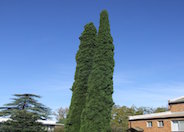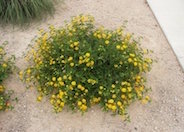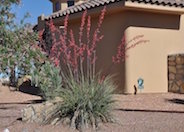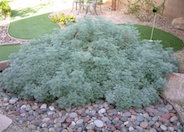
Common name:Italian Cypress
Botanical name:Cupressus sempervirens
Native to southern Europe, western Asia. With its narrow columnar habit of growth, this evergreen forms tall, dark green columns 40' to 60' in height. Leaves are dark green and scalelike. Can reach 3' to 10' wide. Does best in full sun. Established plants need little water. Tolerates most soil types as long as it's well draining. A fast growing tree that generally does not require pruning or maintenance. Dry conditions of the Southwest can cause problems with spider mites in early spring. If tree appears 'dusty', washing the tree down with a jet of water can help. This washing needs to be repeated five days later to control mites.

Common name:Improved Lantana
Botanical name:Lantana hybrid
Mounding trailing groundcover grows quickly to 2' x 3'. Leaves are medium green. Leaves and sap may irritate skin. Vibrant summer color. Attracts butterflies. Full sun. Flowers year-round in frost-free weather. If hit by frost wait until spring to prune back. Many hybrids, look for a variety of flower colors.

Common name:Red Yucca
Botanical name:Hesperaloe parviflora
Upright rosettes grow quickly to 3' x 5' wide. Spectacular accent for desert landscape. Leaves are dark green and strap-like. Coral red flower spikes emerge in spring & remain on plant till end of summer. Tolerates tough conditions including reflected heat and frost. Attracts humingbirds. Native to western Texas and northeastern Mexico.

Common name:Powis Castle Artemisia
Botanical name:Artemisia 'Powis Castle'
This mounding shrub reaches 3 ft. high and up to 5ft. wide with fine silver foliage. It does well in coastal areas as well as inland warm areas. It rarely blooms but is used for its beautiful foliage. It is striking next to perennials with bright colors. This shrub prefers full sun and well draining soil. It is drought tolerant once it's established.
Designer: Jonathon Gore
Photographer: GardenSoft
Incorporate compost 6" into your soil to retain water, reduce compaction, feed earthworms, and provide valuable nutrients to your plants.
Remember to check your irrigation system at least once a month, especially your valves, sprinkler heads, and drip emitters.
Remove irrigation water and fertilizer from areas where you don't want weeds to grow.